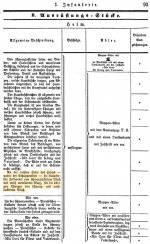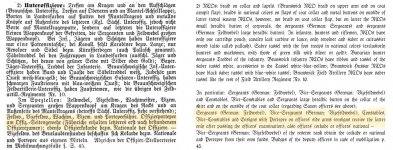Sandmann
Well-known member
Dear friends,
I’m very happy to show you my latest acquisition. At €1085 it might be a bit too expensive, but I've been flirting with an older helmet for a while, which I've now bought before I can’t buy anything because of high energy costs
It is a M1871 private purchased helmet of a Prussian infantry NCO in relatively great condition. The only flaw is a somewhat loosened rear visor on both ends. But to make sure the helmet lasts and the rear visor matches the wonderful overall condition, I bought some antique cotton thread to stich it back on. I've been wanting to restore a helmet for a while now, and this mini-restoration is a very good starter project, I hope. For stitching I will use the Sattler stitch, whose execution and advantages I would like to introduce to you later in this post.
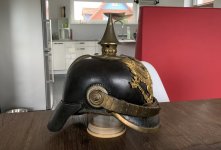
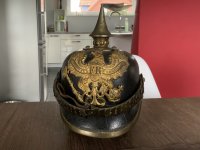
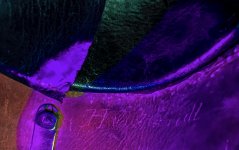
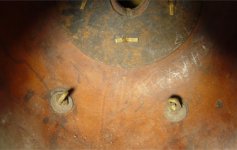
On the rear visor the name "Hildebrandt" was carved I think, but I am not 100% sure. It would be awesome to find some information about the owner, I will keep on inversigate about that. The size of the helmet is indicated by a pencil note inside the helmet body as size 55 and the leather shell has no double holes. The fasteners look like they have not been loosened in a very long time.
I‘m very happy with the helmet and hope you‘ll like it too
I’m very happy to show you my latest acquisition. At €1085 it might be a bit too expensive, but I've been flirting with an older helmet for a while, which I've now bought before I can’t buy anything because of high energy costs
It is a M1871 private purchased helmet of a Prussian infantry NCO in relatively great condition. The only flaw is a somewhat loosened rear visor on both ends. But to make sure the helmet lasts and the rear visor matches the wonderful overall condition, I bought some antique cotton thread to stich it back on. I've been wanting to restore a helmet for a while now, and this mini-restoration is a very good starter project, I hope. For stitching I will use the Sattler stitch, whose execution and advantages I would like to introduce to you later in this post.


- The helmet height of 23 cm is slightly below my expected height (24 cm - 26 cm). The helmet shell is also just about 11 cm high. The weight of the helmet is with 585 g fully in the expected range (500g - 700g). Also the spike is with only 9 cm height (incl. plate fitting) somewhat under the height of 10.5 - 11.5 cm specified in the service regulation.
- The rear visor is still very long (5.7 cm) to keep the rain away from the neck as effectively as possible. However, since it often clashed against the knapsack when the soldier was lying down to shoot, the rear visor was somewhat reduced in size on the following helmet type M1887.
- The back spine, reintroduced in 1871, is completely smooth on the outside. As expected, there are no fasteners to be seen, as these were soldered to the inside of the spine for the first time.
- The heraldic eagle still has a nice gilding. The M1871 plate is well identified by the 3 short tail feathers right at the base, forming a "vVv" arrangement and a little remaining material between wings and legs. The plate is about 125 mm tall in radians, from the end of the tail feathers to the tip of the crown.
- The chinscales are in very good condition. The leather, the strap and buckle look very good.
- The lining is made of 13-fold black leather with square tongues, as it was normal on private purchased helmets until 1880.


On the rear visor the name "Hildebrandt" was carved I think, but I am not 100% sure. It would be awesome to find some information about the owner, I will keep on inversigate about that. The size of the helmet is indicated by a pencil note inside the helmet body as size 55 and the leather shell has no double holes. The fasteners look like they have not been loosened in a very long time.
I‘m very happy with the helmet and hope you‘ll like it too
Last edited:

